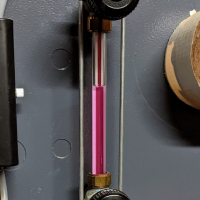Welcome! Here are the website rules, as well as some tips for using this forum.
Need to contact us? Visit https://heatinghelp.com/contact-us/.
Click here to Find a Contractor in your area.
Leak on Single-pipe return
Fizz
Member Posts: 547
Daughter has small leak on return pipe; what is best approach for replacement?

0
Comments
-
In my experience, small leaks get bigger. And multiply. The best thing to do is to take the section of pipe out -- including that coupling -- and replace it. I don't know where the other end of the pipe -- to the right in the picture -- goes, but I'd be inclined to take it out from the elbow on the left at least to the next fitting on the right.Br. Jamie, osb
Building superintendent/caretaker, 7200 sq. ft. historic house museum with dependencies in New England2 -
I would take a sawzall or a grinder with a cutting disk (ware goggles or face shield) and cut directly through the middle of the coupling.
also cut the pipe near the elbow and remove the pipe. Take the angle grinder and slice the remaining half coupling (on the right) along it's length. Don't cut into the pipe threads but cut as deep as possible. Drive and old screwdriver into the cut and open up the coupling so you can remove it.
Remove the old elbow the same way. Clean up the old threads by running a die over them. Then replace with a new elbow, a union and a new pc of pipe
1 -
Now I have direction, thanks!0
-
I might be dealing with the same leak, sounds replacing is the best thing to do indeed.0
-
Indeed!0
-
-
From your picture that sure looks like a thread protector and not a coupling.0
-
you right Fusionman. But in the east guys have used them for couplings forever. I'm not saying its right,`- my guys arn't allowed to used them.gwgillplumbingandheating.com
Serving Cleveland's eastern suburbs from Cleveland Heights down to Cuyahoga Falls.0 -
What's the advantage of a coupling v thread protector?
0 -
Fizz, there is a another discussion about "Thread Protector" down on the page, for you info.0
-
As far as I know, a thread protect is a thread protector, put on a pipe to protect the threads during shipping.Fizz said:What's the advantage of a coupling v thread protector?
A coupling is made to join two together.
A thread protector in general doesn't have tapered threads. A coupling does.Single pipe quasi-vapor system. Typical operating pressure 0.14 - 0.43 oz. EcoSteam ES-20 Advanced Control for Residential Steam boilers. Rectorseal Steamaster water treatment1 -
Thanks guys!0
-
Yep. Thread protectors are prone to fail at some point and perhaps sooner than regular couplings... esp. on a gas line when someone used a hardening pipe dope. Ask me how I know... granted it lasted 60+ years, but it's a pita when you are the new(er) owner of said property and have to completely repipe some 80 feet of black iron, as every single one of them merchant couplings started leaking, conveniently tucked away behind and above hot air registers requiring them all be removed... over a Thanksgiving weekend... ugh... new fittings received both the yellow Teflon tape AND non-hardening pipe dope, and a mandatory -8 turns into new fittings...0
-
Miland:
Was the pressure changed from ounces to pounds for the inside piping recently?0 -
No changes as far as I know... oz of pressure is standard for what I am aware of... I then also ran cst as there was no way to get to some of the pipes without essentially having to redo even more of the heating ducts too - I had to measure for capacity making sure it's sufficient on the length and size, install bonding clamps, 6ga wire into the electric board... it took me 30 hours to get it fixed plus a materials run all over the town - Thanksgiving weekend and not one supplier had all I needed...JUGHNE said:Miland:
Was the pressure changed from ounces to pounds for the inside piping recently?
At any rate, after repiping, I had to pass 10psi test for 10 min before utility would reconnect the meter... had to also replace all those old oil-seal brass service valves on all appliances (4 furnaces, 4 stoves and 4 gas DHW). Gas smell in the basement was amazing - I never smelled it that strong anywhere - EVER. There was at least 10 couplings (well, and els for that matter) that all failed at the same time, on 3 separate gas lines... dried-out dope and underthreaded pipes - original installers did maybe 5 turns at the most, and some pipe didn't even have more than 6 threads threaded on... The worst offenders were merchant couplings... goose-neck gas leak detector on them merchant couplings was flashing like it was a national emergency!0
Categories
- All Categories
- 85.2K THE MAIN WALL
- 3.1K A-C, Heat Pumps & Refrigeration
- 55 Biomass
- 424 Carbon Monoxide Awareness
- 73 Chimneys & Flues
- 1.9K Domestic Hot Water
- 5.2K Gas Heating
- 129 Geothermal
- 160 Indoor-Air Quality
- 3.3K Oil Heating
- 61 Pipe Deterioration
- 884 Plumbing
- 5.9K Radiant Heating
- 375 Solar
- 14.7K Strictly Steam
- 3.2K Thermostats and Controls
- 58 Water Quality
- 49 Industry Classes
- 89 Job Opportunities
- 28 Recall Announcements





